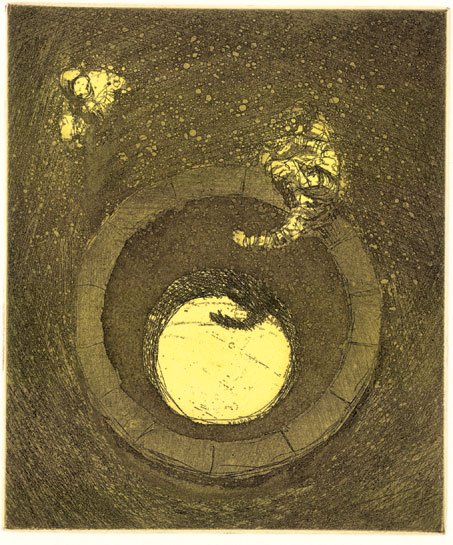Lettnin, Alexandre - VM - Marleen Hengelaar
Alexandre Lettnin: Living Water

I Am the Living Water
by Marleen Hengelaar-Rookmaaker
Around the hot noon hour Jesus arrives at the Well of Jacob in Samaria, tired of the journey, hungry and thirsty. The disciples have gone into town to buy food. A woman comes to draw water from the well at a time of day when she knows for certain she will not run into the other women of the village. She avoids them, as they shut her out because of her reprehensible lifestyle. She too is thirsty. (See John 4:1-30)
At the well she meets a stranger, a Jew, an outsider just like her. Jesus asks her for a drink of water. The woman is surprised and tells him so. She does not mince her words: ‘How is it that you, a Jew, asks a drink of me, a woman of Samaria?’ They become involved in a deep personal and theologically tinged conversation.
The Brazilian artist, Alexandre Lettnin, has captured this encounter in a way totally his own. When he lived in Europe and as a foreigner felt lonely and quite unhappy there. Lettnin was moved by the loving attitude of Christ towards the woman: Jesus knows her hardships, pain, weaknesses and sins and wants to free her from them.
Lettnin has reduced the setting of the conversation in his etching to its essence. We only see the woman, the well and Jesus. The woman is just a small and skinny little puppet who, suspicious and wounded as she is, keeps Jesus at a distance with her assertive questions. Jesus at the other hand bends towards her, full of attention, making an inviting gesture.
Lettnin has opted for a ‘God’s eye view’. We see the scene from above, as God sees it from heaven. God sees us standing in the dark, while at the same time seeing the light he wants to lead us towards. That is what this biblical passage is about. For Jesus also sees this woman standing in the darkness and wants to draw her into the light. He sees what she is like, but also what she could be.
Jesus offers this thirsty woman a new life. He says: ‘The water that I give will become a spring of water gushing up to eternal life.’ In the print the water in the well reflects the light of the sky, which contrast with the dark that is enveloping the woman. At the same time we see the hand of Jesus mirrored in the water. The way to the living water and the light is Jesus himself.
The well is circular, which refers to eternity - without beginning or end, always continuing. Thus life and death are juxtaposed: the woman with her hollow eyes and skull-like face over against the round well with Jesus’ welcoming hand above the water, which forms a passage to the light and eternal life.
This eternal life includes a new life here and now. Jesus offers the Samaritan woman inner restoration: thirst quenching, purifying, abundantly bubbling water through which she can progressively come to flourishing. At the end of their conversation the woman has lost her fear and runs towards her fellow villagers to openly testify about the coming of the Messiah. No wonder the artist has suffused the print with a warm soft yellow glow.
*******
Alexandre Lettnin: Living Water, Paris, 2000, etching and aquatint on Salland paper.
Alexandre Lettnin was born in 1971 in Brazil. He attended the College of Visual Arts in Pelotas, Brazil (1993-1997), which awakened a passion for engraving in him. In 1998 he studied drawing, engraving and printing in the Atelier Livre in Porto Alegre in Southern Brazil. In 1999, at the invitation of the Danish engraver Torben Bo Halbirk, he attended a training in residence in order to specialize in the technique of engraving (Heyter method) in his studio in France, which resulted in an exhibition in Paris. He settled in Paris in a Reformed Church in the neighborhood of Belleville and had the opportunity to work with many artists from other fields like music, dance, film, web design, theater and participate in the Belleville Artists Association and La Fonderie. In the following years he studied in Luxembourg (water-ink) and Spain (lithograph). Returning to live in his hometown in 2004, he joined the faculty at the College of Arts there, teaching drawing and engraving for three years. Currently he works full-time in his own studio. www.lettnin.blogspot.com
Marleen Hengelaar-Rookmaaker is ArtWay’s editor in chief.
ArtWay Visual Meditation August 21, 2016


